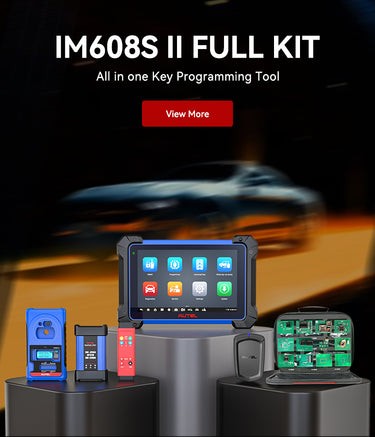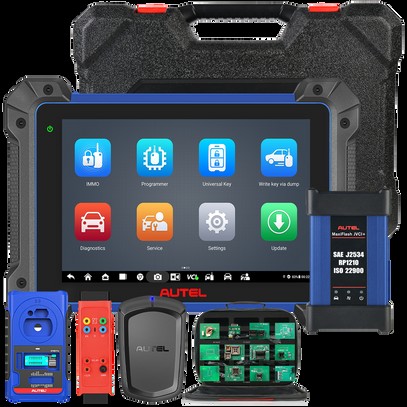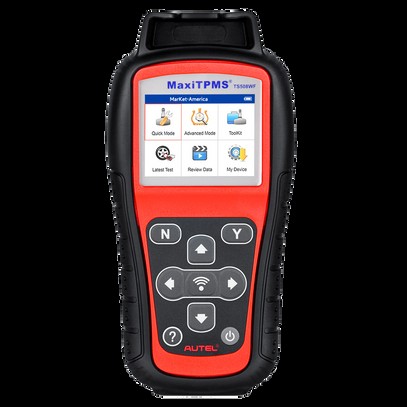A Diagnostic Scan Tool For Personal Cars is an invaluable device that allows you to quickly and accurately identify issues within your vehicle’s systems. With a scan tool, you can read diagnostic trouble codes (DTCs), view live data, and even perform some basic repairs yourself. This guide from CAR-TOOL.EDU.VN will explore the various types of scan tools available, their benefits, and how to choose the right one for your needs.
Contents
- 1. Understanding the Diagnostic Scan Tool for Personal Cars
- 1.1. The Role of OBD2 in Modern Vehicles
- 1.2. Key Components of a Diagnostic Scan Tool
- 1.3. The Evolution of Automotive Diagnostics
- 2. Types of Diagnostic Scan Tools for Personal Cars
- 2.1. Basic Code Readers
- 2.2. Enhanced Scan Tools
- 2.3. Professional-Grade Diagnostic Platforms
- 2.4. Smartphone-Based OBD2 Scanners
- 3. Benefits of Using a Diagnostic Scan Tool
- 3.1. Cost Savings
- 3.2. Time Savings
- 3.3. Improved Vehicle Maintenance
- 3.4. Empowerment Through DIY Diagnostics
- 4. Key Features to Look for in a Diagnostic Scan Tool
- 4.1. Compatibility
- 4.2. Ease of Use
- 4.3. Data Display
- 4.4. Special Functions
- 5. Top Diagnostic Scan Tools for Personal Cars in 2024
- 5.1. Autel MaxiSys MS906 Pro
- 5.2. Innova 3100RS
- 5.3. BlueDriver Bluetooth Professional OBDII Scan Tool
- 5.4. FIXD Sensor Professional Scan Tool
- 5.5. Bosch ADS 525X
- 6. How to Use a Diagnostic Scan Tool
- 6.1. Locating the OBD2 Port
- 6.2. Connecting the Scan Tool
- 6.3. Reading Diagnostic Trouble Codes (DTCs)
- 6.4. Interpreting Live Data
- 6.5. Clearing Diagnostic Trouble Codes (DTCs)
- 7. Common Diagnostic Trouble Codes (DTCs) and Their Meanings
- 7.1. P0300: Random/Multiple Cylinder Misfire Detected
- 7.2. P0171: System Too Lean (Bank 1)
- 7.3. P0420: Catalyst System Efficiency Below Threshold (Bank 1)
- 7.4. P0700: Transmission Control System Malfunction
- 7.5. B1000: Control Module
- 8. Maintaining and Updating Your Diagnostic Scan Tool
- 8.1. Software Updates
- 8.2. Cleaning and Storage
- 8.3. Battery Maintenance
- 9. The Future of Automotive Diagnostics
- 9.1. AI-Powered Diagnostics
- 9.2. Remote Diagnostics
- 9.3. Integration with ADAS
- 10. Getting Expert Advice from CAR-TOOL.EDU.VN
- 10.1. Personalized Consultation
- 10.2. Comprehensive Product Information
- 10.3. Reliable Suppliers
- 10.4. Expert Reviews and Recommendations
- 10.5. Immediate Assistance
- FAQ: Diagnostic Scan Tools for Personal Cars
- 1. What is the best diagnostic scan tool for beginners?
- 2. Can a diagnostic scan tool fix my car?
- 3. How often should I use a diagnostic scan tool?
- 4. Are smartphone-based OBD2 scanners reliable?
- 5. Can a diagnostic scan tool reset my oil life light?
- 6. What does “bi-directional control” mean in a scan tool?
- 7. How do I update the software on my diagnostic scan tool?
- 8. What is the difference between OBD1 and OBD2?
- 9. Can a diagnostic scan tool read ABS and SRS codes?
- 10. Where can I buy a reliable diagnostic scan tool?
1. Understanding the Diagnostic Scan Tool for Personal Cars
What exactly is a diagnostic scan tool for personal cars?
A diagnostic scan tool for personal cars, often referred to as an OBD2 scanner, is an electronic device used to communicate with a vehicle’s onboard computer system. It accesses data related to the engine, transmission, ABS, airbags, and other critical systems. According to the Environmental Protection Agency (EPA), all cars and light trucks manufactured since 1996 are required to have an OBD2 port, making these scan tools universally compatible with modern vehicles. These tools can read and interpret diagnostic trouble codes (DTCs), which are codes stored by the vehicle’s computer to indicate a problem. They also provide live data, allowing you to monitor the performance of various components in real-time.
1.1. The Role of OBD2 in Modern Vehicles
How does OBD2 enhance vehicle diagnostics?
On-Board Diagnostics II (OBD2) is a standardized system that provides access to a vehicle’s health information. As stated by the Society of Automotive Engineers (SAE), the OBD2 standard ensures that any compliant scan tool can communicate with any OBD2-equipped vehicle, regardless of make or model. This standardization enables mechanics and car owners alike to diagnose problems quickly and efficiently. The OBD2 system monitors various engine and emission-related components, alerting the driver to potential issues through the “check engine” light. A diagnostic scan tool can then be used to read the specific DTCs and provide insight into the nature of the problem.
1.2. Key Components of a Diagnostic Scan Tool
What are the essential features to look for in a diagnostic scan tool?
A diagnostic scan tool typically includes several key components: a connector to plug into the vehicle’s OBD2 port, a display screen to view data, buttons or a touchscreen for navigation, and software for interpreting the data. More advanced tools may also include features such as Wi-Fi connectivity for software updates, Bluetooth for wireless connection to a smartphone or tablet, and the ability to perform bi-directional controls, which allow you to command the vehicle’s systems to perform specific actions.
1.3. The Evolution of Automotive Diagnostics
How have diagnostic tools evolved over time?
Automotive diagnostics have evolved significantly from basic fault codes to sophisticated data analysis and bi-directional control. In the early days of automotive diagnostics, mechanics relied on simple test lights and vacuum gauges to diagnose problems. With the advent of OBD2 in the mid-1990s, diagnostic scan tools became more standardized and accessible. Today’s advanced scan tools offer a wealth of information, including live data streams, freeze frame data, and the ability to perform advanced functions such as module programming and key fob programming.
2. Types of Diagnostic Scan Tools for Personal Cars
What are the different types of diagnostic scan tools available?
Diagnostic scan tools for personal cars come in various forms, each with its own set of features and capabilities. The main types include basic code readers, enhanced scan tools, and professional-grade diagnostic platforms.
2.1. Basic Code Readers
What can you achieve with a basic code reader?
Basic code readers are the simplest and most affordable type of scan tool. They are designed to read and clear DTCs, providing a quick and easy way to identify and resolve common issues. These tools typically display the DTC and a brief description of the problem. While basic code readers are limited in their capabilities, they can be a valuable tool for DIY mechanics and car owners who want to perform basic diagnostics.
2.2. Enhanced Scan Tools
What additional functionalities do enhanced scan tools offer?
Enhanced scan tools offer more advanced features compared to basic code readers. In addition to reading and clearing DTCs, they can display live data streams, allowing you to monitor the performance of various sensors and components in real-time. Enhanced scan tools may also offer access to additional vehicle systems, such as ABS and airbag systems, and may include features such as freeze frame data, which captures a snapshot of the vehicle’s operating conditions when a DTC is triggered.
2.3. Professional-Grade Diagnostic Platforms
What sets professional-grade diagnostic platforms apart?
Professional-grade diagnostic platforms are the most advanced and comprehensive type of scan tool. They offer a wide range of features and capabilities, including bi-directional controls, advanced coding and programming functions, and access to vehicle-specific diagnostic information. These tools are typically used by professional mechanics and technicians in automotive repair shops. According to a report by the Auto Care Association, professional-grade diagnostic tools can significantly reduce diagnostic time and improve the accuracy of repairs.
2.4. Smartphone-Based OBD2 Scanners
How do smartphone-based OBD2 scanners work?
Smartphone-based OBD2 scanners are compact devices that plug into the OBD2 port and communicate with a smartphone or tablet via Bluetooth or Wi-Fi. These scanners typically work with a dedicated app that displays diagnostic information and allows you to read and clear DTCs. Smartphone-based OBD2 scanners offer a convenient and affordable way to perform basic diagnostics, and many apps offer advanced features such as live data monitoring and custom dashboards.
 Smartphone-based OBD2 scanners offer a convenient way to perform basic diagnostics using a dedicated app.
Smartphone-based OBD2 scanners offer a convenient way to perform basic diagnostics using a dedicated app.
3. Benefits of Using a Diagnostic Scan Tool
Why should you invest in a diagnostic scan tool?
Using a diagnostic scan tool offers numerous benefits, including cost savings, time savings, and improved vehicle maintenance.
3.1. Cost Savings
How can a scan tool save you money on car repairs?
A diagnostic scan tool can save you money by allowing you to identify and resolve minor issues before they turn into major problems. By reading DTCs and monitoring live data, you can diagnose problems early and perform simple repairs yourself, avoiding costly trips to the mechanic. According to a survey by Consumer Reports, car owners who perform regular maintenance can save an average of $1,200 per year on repair costs.
3.2. Time Savings
How does a scan tool reduce diagnostic time?
A diagnostic scan tool can significantly reduce diagnostic time by providing quick and accurate information about your vehicle’s systems. Instead of spending hours troubleshooting a problem, you can use a scan tool to pinpoint the source of the issue in a matter of minutes. This can be particularly valuable in emergency situations, such as when your car breaks down on the side of the road.
3.3. Improved Vehicle Maintenance
How does a scan tool help with vehicle maintenance?
Regular use of a diagnostic scan tool can help you maintain your vehicle in optimal condition. By monitoring live data and checking for DTCs, you can identify potential problems early and take corrective action before they lead to more serious issues. This can help extend the life of your vehicle and improve its overall performance.
3.4. Empowerment Through DIY Diagnostics
How does a scan tool empower car owners to perform their own diagnostics?
A diagnostic scan tool empowers car owners to take control of their vehicle’s maintenance and repair. By providing access to diagnostic information, a scan tool allows you to understand the inner workings of your car and make informed decisions about repairs. This can be particularly valuable for those who enjoy working on their own cars and want to save money on labor costs.
4. Key Features to Look for in a Diagnostic Scan Tool
What features are essential when choosing a diagnostic scan tool?
When choosing a diagnostic scan tool, consider the following key features: compatibility, ease of use, data display, and special functions.
4.1. Compatibility
Is the scan tool compatible with your vehicle?
Compatibility is one of the most important factors to consider when choosing a diagnostic scan tool. Ensure that the tool is compatible with your vehicle’s make, model, and year. Most scan tools support all OBD2-compliant vehicles, but some may offer enhanced support for specific makes and models.
4.2. Ease of Use
How user-friendly is the scan tool?
Choose a scan tool that is easy to use and navigate. Look for features such as a clear display screen, intuitive menu system, and helpful documentation. Some scan tools also offer multilingual support, which can be beneficial for users who are not fluent in English.
4.3. Data Display
What types of data can the scan tool display?
Consider the types of data that the scan tool can display. Look for features such as live data streams, freeze frame data, and the ability to graph data over time. These features can help you diagnose complex problems and monitor the performance of your vehicle’s systems.
4.4. Special Functions
What special functions does the scan tool offer?
Some scan tools offer special functions such as bi-directional controls, coding and programming functions, and the ability to reset service lights. These functions can be valuable for performing advanced repairs and maintenance tasks.
 Autel MaxiSys Ultra EV, a professional-grade diagnostic platform, offers a wide range of features and capabilities.
Autel MaxiSys Ultra EV, a professional-grade diagnostic platform, offers a wide range of features and capabilities.
5. Top Diagnostic Scan Tools for Personal Cars in 2024
What are the best diagnostic scan tools available on the market today?
Here are some of the top diagnostic scan tools for personal cars in 2024, based on features, performance, and user reviews:
5.1. Autel MaxiSys MS906 Pro
What makes the Autel MaxiSys MS906 Pro a top choice?
The Autel MaxiSys MS906 Pro is a professional-grade diagnostic tablet that offers a wide range of features and capabilities. It supports advanced diagnostics, bi-directional controls, and coding and programming functions. The MS906 Pro also features a user-friendly interface and a large, high-resolution display.
5.2. Innova 3100RS
What are the key features of the Innova 3100RS?
The Innova 3100RS is a popular choice for DIY mechanics and car owners. It offers a balance of features and affordability, including the ability to read and clear DTCs, view live data, and perform battery and charging system tests. The 3100RS also features a patented all-in-one display and hotkeys for quick access to commonly used functions.
5.3. BlueDriver Bluetooth Professional OBDII Scan Tool
What advantages does the BlueDriver Bluetooth Scan Tool offer?
The BlueDriver Bluetooth Professional OBDII Scan Tool is a smartphone-based scanner that offers a convenient and affordable way to perform diagnostics. It works with a dedicated app that provides access to a wealth of diagnostic information, including DTC definitions, repair reports, and live data. The BlueDriver also offers advanced features such as enhanced diagnostics for ABS and airbag systems.
5.4. FIXD Sensor Professional Scan Tool
What sets the FIXD Sensor Professional Scan Tool apart?
The FIXD Sensor Professional Scan Tool is another popular smartphone-based scanner that offers a range of features for DIY mechanics and car owners. It provides real-time monitoring of your vehicle’s health, sends alerts when problems are detected, and offers repair guidance and cost estimates.
5.5. Bosch ADS 525X
Why is the Bosch ADS 525X a recommended diagnostic tool?
The Bosch ADS 525X is a comprehensive diagnostic scan tool designed for professional technicians. It offers advanced features such as bi-directional control, complete system scans, and detailed repair information. The ADS 525X is also equipped with a user-friendly touchscreen interface and wireless connectivity for easy software updates.
6. How to Use a Diagnostic Scan Tool
What are the basic steps for using a diagnostic scan tool?
Using a diagnostic scan tool is a straightforward process. Here are the basic steps:
6.1. Locating the OBD2 Port
Where is the OBD2 port located in your car?
The OBD2 port is typically located under the dashboard on the driver’s side of the vehicle. It is usually a 16-pin connector that is easily accessible. Refer to your vehicle’s owner’s manual for the exact location of the OBD2 port.
6.2. Connecting the Scan Tool
How do you properly connect the scan tool to the OBD2 port?
Plug the scan tool into the OBD2 port. Ensure that the connection is secure and that the scan tool is powered on.
6.3. Reading Diagnostic Trouble Codes (DTCs)
How do you retrieve and interpret DTCs?
Turn the ignition key to the “on” position, but do not start the engine. Follow the scan tool’s instructions to read DTCs. The scan tool will display the DTCs along with a brief description of the problem.
6.4. Interpreting Live Data
How can live data help diagnose vehicle issues?
Use the scan tool to view live data streams from various sensors and components. Monitor the data for any abnormal readings or fluctuations. This can help you identify the source of the problem.
6.5. Clearing Diagnostic Trouble Codes (DTCs)
When is it appropriate to clear DTCs?
After you have identified and resolved the problem, use the scan tool to clear the DTCs. This will turn off the “check engine” light. Note that clearing DTCs without addressing the underlying issue will only result in the light turning back on later.
 Autel MaxiIM IM608 Pro II Full Kit, an all-in-one key programming tool, is used by professional locksmiths.
Autel MaxiIM IM608 Pro II Full Kit, an all-in-one key programming tool, is used by professional locksmiths.
7. Common Diagnostic Trouble Codes (DTCs) and Their Meanings
What are some of the most common DTCs you might encounter?
Here are some of the most common DTCs and their meanings:
7.1. P0300: Random/Multiple Cylinder Misfire Detected
What does a P0300 code indicate?
The P0300 code indicates that the engine is experiencing a random or multiple cylinder misfire. This can be caused by a variety of issues, including faulty spark plugs, ignition coils, fuel injectors, or vacuum leaks.
7.2. P0171: System Too Lean (Bank 1)
What does a P0171 code signify?
The P0171 code indicates that the engine is running too lean on bank 1. This means that there is too much air and not enough fuel in the air-fuel mixture. This can be caused by a vacuum leak, faulty oxygen sensor, or a clogged fuel filter.
7.3. P0420: Catalyst System Efficiency Below Threshold (Bank 1)
What does a P0420 code mean?
The P0420 code indicates that the catalytic converter is not functioning efficiently. This can be caused by a variety of issues, including a faulty oxygen sensor, exhaust leak, or a damaged catalytic converter.
7.4. P0700: Transmission Control System Malfunction
What does a P0700 code indicate?
The P0700 code indicates that there is a malfunction in the transmission control system. This can be caused by a variety of issues, including faulty sensors, solenoids, or a damaged transmission control module.
7.5. B1000: Control Module
What does a B1000 code signify?
The B1000 code indicates that there is an internal fault in the control module. The most common cause is voltage outside of its operating range.
8. Maintaining and Updating Your Diagnostic Scan Tool
How do you keep your scan tool in good working condition?
To ensure that your diagnostic scan tool remains in good working condition, follow these maintenance tips:
8.1. Software Updates
How important are software updates for your scan tool?
Regularly update the scan tool’s software to ensure that it has the latest diagnostic information and features. Many scan tools offer automatic software updates via Wi-Fi or USB.
8.2. Cleaning and Storage
How should you clean and store your scan tool?
Keep the scan tool clean and dry. Store it in a safe place when not in use to prevent damage.
8.3. Battery Maintenance
How do you maintain the battery of your scan tool?
If the scan tool has a built-in battery, follow the manufacturer’s instructions for battery maintenance. Avoid exposing the battery to extreme temperatures or moisture.
9. The Future of Automotive Diagnostics
What trends are shaping the future of automotive diagnostics?
The future of automotive diagnostics is being shaped by several key trends, including the increasing complexity of vehicle systems, the rise of connected car technologies, and the growing demand for remote diagnostics.
9.1. AI-Powered Diagnostics
How will artificial intelligence impact automotive diagnostics?
Artificial intelligence (AI) is playing an increasingly important role in automotive diagnostics. AI-powered diagnostic tools can analyze vast amounts of data to identify patterns and predict potential problems before they occur.
9.2. Remote Diagnostics
What are the benefits of remote diagnostics?
Remote diagnostics allow technicians to diagnose and repair vehicles remotely, using telematics data and video conferencing. This can be particularly valuable for diagnosing problems in remote locations or for providing support to DIY mechanics.
9.3. Integration with ADAS
How are diagnostic tools adapting to Advanced Driver Assistance Systems (ADAS)?
Advanced Driver Assistance Systems (ADAS) are becoming increasingly common in modern vehicles. Diagnostic tools are being developed to support the calibration and maintenance of ADAS components, such as cameras, radar sensors, and lane departure warning systems.
 MaxiTPMS TS508WF, a new generation TPMS tool, provides faster and smarter TPMS repairs.
MaxiTPMS TS508WF, a new generation TPMS tool, provides faster and smarter TPMS repairs.
10. Getting Expert Advice from CAR-TOOL.EDU.VN
How can CAR-TOOL.EDU.VN assist you in choosing the right diagnostic scan tool and automotive tools?
At CAR-TOOL.EDU.VN, we understand the challenges of finding reliable automotive parts and tools. We offer detailed information on a wide range of diagnostic scan tools, auto parts, and repair tools. Our goal is to provide you with the information you need to make informed decisions and keep your vehicle running smoothly.
10.1. Personalized Consultation
Looking for personalized advice? Contact us via Whatsapp at +1 (641) 206-8880 or visit us at 456 Elm Street, Dallas, TX 75201, United States, and let our experts guide you in selecting the perfect diagnostic scan tool and automotive tools for your specific needs.
10.2. Comprehensive Product Information
CAR-TOOL.EDU.VN provides detailed specifications, comparisons, and user reviews to help you evaluate different diagnostic scan tools and automotive tools.
10.3. Reliable Suppliers
We connect you with reputable suppliers to ensure you receive high-quality products at competitive prices.
10.4. Expert Reviews and Recommendations
Our team of experts offers unbiased reviews and recommendations, saving you time and effort in your search for the right tools and parts.
10.5. Immediate Assistance
Do you have questions or need immediate assistance? Contact us now to get expert advice and answers to all your questions!
FAQ: Diagnostic Scan Tools for Personal Cars
1. What is the best diagnostic scan tool for beginners?
The Innova 3100RS is a great option for beginners due to its ease of use and affordability. It provides essential features like reading and clearing DTCs and viewing live data.
2. Can a diagnostic scan tool fix my car?
A diagnostic scan tool can help identify the problem, but it cannot physically fix your car. It provides the diagnostic information needed for repairs.
3. How often should I use a diagnostic scan tool?
You should use a diagnostic scan tool whenever you notice a problem with your car or when the “check engine” light comes on. Regular checks can also help prevent major issues.
4. Are smartphone-based OBD2 scanners reliable?
Yes, smartphone-based OBD2 scanners can be reliable if you choose a reputable brand and use a compatible app. They offer a convenient way to perform basic diagnostics.
5. Can a diagnostic scan tool reset my oil life light?
Many enhanced and professional-grade diagnostic scan tools can reset the oil life light. Check the tool’s specifications to ensure it supports this function.
6. What does “bi-directional control” mean in a scan tool?
Bi-directional control allows the scan tool to send commands to the vehicle’s systems, such as turning on the cooling fan or activating the fuel pump, to test their functionality.
7. How do I update the software on my diagnostic scan tool?
Most scan tools can be updated via Wi-Fi or USB. Follow the manufacturer’s instructions to download and install the latest software updates.
8. What is the difference between OBD1 and OBD2?
OBD1 was used in vehicles before 1996 and was not standardized, meaning each manufacturer had its own diagnostic system. OBD2 is a standardized system used in all vehicles manufactured since 1996, making it universally compatible with scan tools.
9. Can a diagnostic scan tool read ABS and SRS codes?
Enhanced and professional-grade diagnostic scan tools can read ABS (Anti-lock Braking System) and SRS (Supplemental Restraint System) codes. Basic code readers typically only read engine-related codes.
10. Where can I buy a reliable diagnostic scan tool?
You can purchase reliable diagnostic scan tools from automotive parts stores, online retailers like CAR-TOOL.EDU.VN, and tool suppliers. Always check user reviews and ratings before making a purchase.
At CAR-TOOL.EDU.VN, we are committed to helping you find the best diagnostic scan tools and automotive solutions. Our team is ready to assist you with any questions and provide expert guidance. Contact us today and let us help you keep your vehicle running smoothly!
Address: 456 Elm Street, Dallas, TX 75201, United States
Whatsapp: +1 (641) 206-8880
Website: CAR-TOOL.EDU.VN
